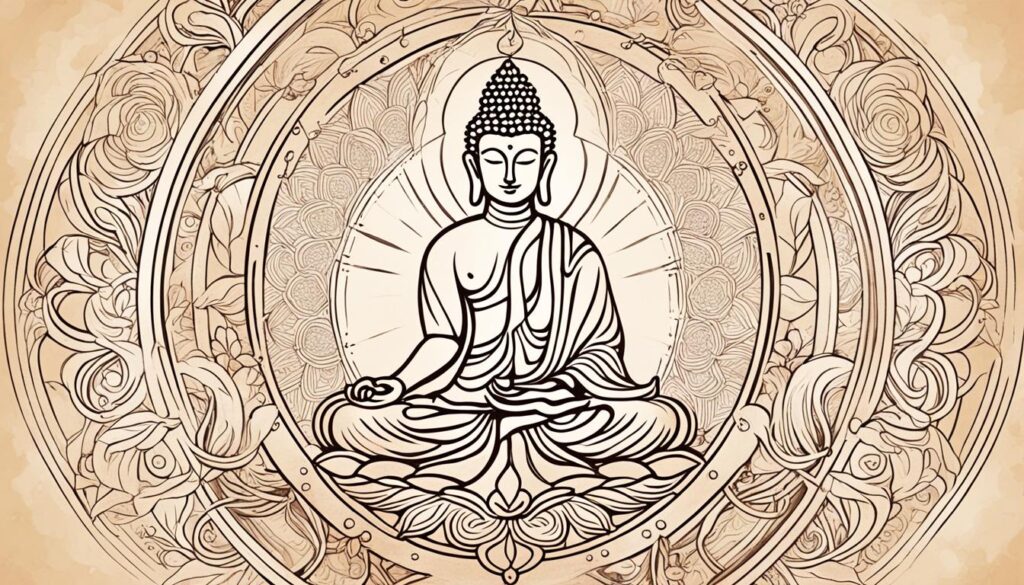Have you ever wondered what sets Mahayana Buddhism apart from other Buddhist traditions? What is it that makes it the largest Buddhist sect in the world? Delve into the fascinating world of Mahayana Buddhism and explore its profound teachings and practices.
Mahayana Buddhism is a school of thought that emerged after 383 BCE, encompassing a rich and expansive interpretation of the Buddha’s teachings. Unlike other sects, Mahayana incorporates a vast body of scriptures known as Mahayana Sutras, offering a comprehensive framework for spiritual growth and enlightenment.
At the core of Mahayana Buddhism is the Bodhisattva ideal, a path where practitioners not only seek personal enlightenment but also aspire to become compassionate beings who postpone their own entry into Nirvana to assist others in their journey towards awakening.
Are you ready to embark on a transformative journey and explore the profound wisdom of Mahayana Buddhism? Join us as we dive deep into its historical roots, doctrine, and practices. Discover the beauty and profound insights that await you on this path of compassion, wisdom, and liberation.
Key Takeaways:
- Mahayana Buddhism is the largest Buddhist sect in the world, known for its expansive interpretation of the Buddha’s teachings.
- Mahayana incorporates a vast body of scriptures known as Mahayana Sutras, which provide a comprehensive guide to spiritual growth.
- The central tenet of Mahayana is the Bodhisattva ideal, where practitioners strive for personal enlightenment and dedicated service to others.
- Embarking on the path of Mahayana Buddhism allows individuals to cultivate compassion, wisdom, and liberation.
- Discover the historical roots, doctrine, and practices of Mahayana Buddhism to gain profound insights into this transformative tradition.
Historical Roots of Theravada Buddhism
Theravada Buddhism, often referred to as the “Teaching of the Elders,” traces its lineage back to the earliest communities of monks and nuns who preserved the Pali Canon, the oldest collection of Buddhist scriptures. This school originated in countries such as Sri Lanka, Thailand, Myanmar, Laos, and Cambodia, and it closely adheres to the original teachings of the historical Buddha, Siddhartha Gautama.
The Pali Canon, also known as the Tripitaka or Three Baskets, is a vast collection of texts that forms the foundation of Theravada Buddhism. It contains discourses, monastic rules, and philosophical treatises attributed to the Buddha and his immediate disciples.
In preserving the Pali Canon, the Theravada tradition emphasizes the importance of lineage and transmission, ensuring the authenticity of the teachings passed down from generation to generation. Monasteries and monastic communities play a pivotal role in the preservation and dissemination of the Pali Canon, cultivating a deep understanding of the Buddha’s teachings.
Theravada Buddhism’s historical roots are deeply intertwined with the cultures and societies of Southeast Asia, where it has thrived for centuries. Today, it continues to be a vibrant tradition practiced by millions of individuals around the world who seek guidance on the path to liberation and enlightenment.
Key Concepts
- Teaching of the Elders: Refers to the traditional name of Theravada Buddhism, highlighting its commitment to preserving and transmitting the original teachings of the Buddha.
- Pali Canon: The oldest collection of Buddhist scriptures in the Theravada tradition, containing discourses, monastic rules, and philosophical treatises attributed to the Buddha and his immediate disciples.
- Lineage and Transmission: Theravada emphasizes the importance of an unbroken lineage of monastic communities in preserving and transmitting the teachings from the Buddha and his disciples.

Doctrine and Practice of Theravada Buddhism
Theravada Buddhism offers a path to personal liberation through dedicated practice and adherence to the Eightfold Path. This ancient tradition places great emphasis on individual effort and discipline, guiding practitioners towards the ultimate goal of Arhatship, the state of complete enlightenment and liberation from suffering.
Central to the practice of Theravada Buddhism is the Vinaya Pitaka, a collection of rules and guidelines for monastic discipline. Monastic life is highly valued in this tradition, with monks and nuns committing themselves to a life of renunciation, moral conduct, and spiritual cultivation.
The Eightfold Path serves as the roadmap for Theravada practitioners, guiding them in cultivating wisdom, ethical conduct, and mental discipline. It consists of the following interconnected elements:
- Right View: Developing a correct understanding of the nature of existence, the Four Noble Truths, and the law of cause and effect.
- Right Intention: Cultivating wholesome intentions, such as renunciation, kindness, and compassion towards oneself and others.
- Right Speech: Practicing truthful, kind, and harmonious speech, avoiding lying, divisive speech, harsh words, and idle gossip.
- Right Action: Abstaining from actions that cause harm, such as killing, stealing, and sexual misconduct.
- Right Livelihood: Engaging in a livelihood that is honest and ethical, avoiding professions that cause harm to oneself or others.
- Right Effort: Cultivating the energy and determination to cultivate wholesome qualities and abandon unwholesome ones.
- Right Mindfulness: Developing mindful awareness of the body, feelings, thoughts, and mental states, fostering non-judgmental observation and insight.
- Right Concentration: Training the mind through meditation to achieve deep levels of concentration and insight, leading to liberation.
The Four Noble Truths
The practice of Theravada Buddhism revolves around the direct realization of the Four Noble Truths, which form the foundation of the Buddha’s teachings:
- Dukkha: The truth of suffering, recognizing the inherent unsatisfactory nature of existence.
- Samudaya: The truth of the origin of suffering, understanding that attachment and craving lead to suffering.
- Nirodha: The truth of the cessation of suffering, realizing that liberation from suffering is attainable through the eradication of craving.
- Magga: The truth of the path leading to the cessation of suffering, following the Eightfold Path to cultivate wisdom, ethical conduct, and mental discipline.

| Key Elements of Theravada Buddhism | Description |
|---|---|
| Personal Liberation (Nirvana) | Emphasis on achieving individual liberation and ending the cycle of rebirth through personal effort and diligent practice. |
| Eightfold Path | A comprehensive framework of practices encompassing wisdom, ethical conduct, and mental discipline to attain liberation. |
| Vinaya Pitaka | A collection of rules and guidelines for monastic discipline, governing the conduct and lifestyle of monastics. |
| Arhatship | The ultimate goal for Theravada practitioners, attaining enlightenment by extinguishing all defilements and achieving Nirvana. |
Historical Roots of Mahayana Buddhism
Mahayana Buddhism emerged several centuries after Theravada and represents a more expansive and inclusive interpretation of the Buddha’s teachings. It spread to regions like China, Japan, Korea, Tibet, and Vietnam. Mahayana incorporates a vast body of scriptures, including the teachings found in the Theravada Canon, as well as additional texts known as Mahayana Sutras.

The Mahayana tradition, also known as the “Great Vehicle,” gained significant momentum during the early centuries of the Common Era. It presented a new vision of Buddhism that resonated with the aspirations of a broader audience, placing a strong emphasis on compassion, wisdom, and the liberation of all sentient beings.
The Mahayana Sutras are a prominent feature of this tradition. These texts, considered to be the words of the Buddha himself, form a rich tapestry of teachings and parables. They elaborate on the concept of the Bodhisattva ideal, illustrating the path of selfless service and compassionate action taken by those who aspire to become enlightened beings for the benefit of all.
The Mahayana Sutras highlight the interconnectedness of all living beings and advocate for the use of skillful means to guide others towards awakening. They also introduce teachings on the nature of reality, the concept of emptiness, and the existence of multiple Buddha realms beyond our immediate perception.
In addition to incorporating teachings from the Theravada Canon, the Mahayana Sutras offer unique insights and practices specific to the Mahayana tradition. They serve as a profound source of inspiration and guidance, illuminating the path to ultimate liberation and the realization of one’s inherent Buddha nature.
This richness and inclusivity define the Mahayana Buddhist tradition, attracting countless individuals seeking spiritual growth and enlightenment. The transformative power of its teachings continues to inspire and guide practitioners on their journey of self-discovery and the pursuit of ultimate truth.
Doctrine and Practice of Mahayana Buddhism
One of the central tenets of Mahayana Buddhism is the Bodhisattva ideal—a commitment to attain Buddhahood for the benefit of all beings. As a practitioner of Mahayana Buddhism, your aspiration extends beyond achieving personal enlightenment to becoming a Bodhisattva.
The ultimate goal is Buddhahood, which embodies wisdom and compassion on an immeasurable scale. In Mahayana Buddhism, meditation holds significant importance as a means to develop mindfulness, concentration, and insight, leading you closer to this transcendental state.
Furthermore, ethical conduct outlined in the Five Precepts serves as the foundation for the path of awakening in Mahayana Buddhism. By adhering to these principles, you embrace compassionate action and strive to alleviate suffering not only for yourself but for all sentient beings.
To deepen your understanding of Mahayana Buddhism and its practices, the Mahayana Sutras provide invaluable wisdom and guidance. These scriptures serve as the source of inspiration and instruction, illuminating the path towards enlightenment and the Bodhisattva ideal.
| Key Elements of Mahayana Buddhism | Description |
|---|---|
| Bodhisattva Ideal | The commitment to attain Buddhahood for the benefit of all beings. |
| Meditation | Significant emphasis on developing mindfulness, concentration, and insight through meditation practices. |
| Ethical Conduct | The Five Precepts guide practitioners towards compassionate action and moral discipline. |
| Mahayana Sutras | Scriptures that offer profound wisdom and guidance on the path to enlightenment and the Bodhisattva ideal. |
Differences and Similarities between Theravada and Mahayana
Both Theravada and Mahayana Buddhism offer unique paths towards enlightenment, each with its own distinct characteristics and focus. Understanding the differences and similarities between these two traditions can provide valuable insights into the diverse approaches to Buddhist practice.
Focus on Individual vs. Universal Liberation
One of the key differences between Theravada and Mahayana lies in their respective perspectives on liberation. Theravada Buddhism places a strong emphasis on individual liberation and personal enlightenment. Practitioners strive to attain the state of Arhatship, achieving liberation from the cycle of birth and death through their own efforts and discipline.
In contrast, Mahayana Buddhism extends beyond individual liberation to include the welfare and liberation of all sentient beings. The central tenet of Mahayana is the Bodhisattva ideal, in which practitioners aspire to become compassionate beings who delay their own entry into Nirvana to assist others. The goal is not simply personal enlightenment but rather the universal liberation and awakening of all living beings.
Nature of the Buddha
Theravada and Mahayana also differ in their understanding of the nature of the Buddha. In Theravada, the Buddha is revered as an exemplary teacher who attained enlightenment through his own effort. The focus is on following his teachings and emulating his path towards liberation.
On the other hand, Mahayana often views the Buddha as an eternal and transcendent figure who manifests in various forms to guide and enlighten beings. The concept of the Buddha’s nature expands to include the idea of a vast, immeasurable reality beyond conventional understanding.
Key Practices
Despite these differences, both Theravada and Mahayana share common aspects in their spiritual practices. Both traditions place great importance on the practice of meditation as a means to develop mindfulness, concentration, and insight. Meditation cultivates self-awareness and leads to the direct realization of the Four Noble Truths.
Furthermore, ethical conduct, outlined in the Five Precepts, is considered fundamental in both Theravada and Mahayana. Living a virtuous and compassionate life is seen as crucial in fostering spiritual growth and aligning one’s actions with the path towards enlightenment.

| Theravada Buddhism | Mahayana Buddhism |
|---|---|
| Emphasizes individual liberation | Focuses on universal liberation |
| Views Buddha as an exemplary teacher | Sees Buddha as an eternal, transcendent figure |
| Emphasizes personal meditation | Emphasizes meditation for the benefit of all beings |
| Values monastic life | Values both monastic and lay practitioners |
Conclusion
Mahayana and Theravada Buddhism offer distinct paths to enlightenment, catering to the diverse needs and aspirations of practitioners. Despite their differences, both schools share a common root in the teachings of the historical Buddha. Whether you choose to follow the “Great Vehicle” of Mahayana or the “Teaching of the Elders” in Theravada, the ultimate destination remains the same – liberation from suffering and the realization of profound wisdom and compassion.
The diversity within the Buddhist tradition presents a vast landscape where these paths converge on the journey toward awakening. Mahayana Buddhism encompasses an expansive interpretation of the Buddha’s teachings, emphasizing the Bodhisattva ideal and the pursuit of universal compassion. On the other hand, Theravada Buddhism focuses on personal liberation through the practice of the Eightfold Path and adherence to the original teachings of the Buddha.
Both traditions place importance on meditation and ethical conduct as means to attain enlightenment. As you explore the rich teachings and practices of Mahayana and Theravada Buddhism, remember that the choice of path is not as significant as the commitment to self-discovery and the cultivation of compassion toward all beings. May your journey on the Buddhist path be filled with wisdom, peace, and the transformation of suffering into liberation.
FAQ
What is Mahayana Buddhism?
Mahayana Buddhism is the largest Buddhist sect in the world, developed as a school of thought after 383 BCE. It is characterized by its expansive and inclusive interpretation of the Buddha’s teachings, incorporating a vast body of scriptures known as Mahayana Sutras. The central tenet of Mahayana is the Bodhisattva ideal, where practitioners strive not only for personal enlightenment but also to become compassionate beings who delay their own entry into Nirvana to assist others.
What is Theravada Buddhism?
Theravada Buddhism, often referred to as the “Teaching of the Elders,” traces its lineage back to the earliest communities of monks and nuns who preserved the Pali Canon, the oldest collection of Buddhist scriptures. This school originated in countries such as Sri Lanka, Thailand, Myanmar, Laos, and Cambodia, and it closely adheres to the original teachings of the historical Buddha, Siddhartha Gautama.
What are the practices of Theravada Buddhism?
Theravada Buddhism emphasizes personal liberation (Nirvana) through individual effort and the practice of the Eightfold Path. The Vinaya Pitaka outlines rules for monastic discipline, and monastic life is highly valued in this tradition. The primary goal for Theravada practitioners is to attain Arhatship, becoming an enlightened being who has extinguished all defilements and achieved Nirvana. The focus is on personal discipline, meditation, and direct realization of the Four Noble Truths.
How did Mahayana Buddhism develop?
Mahayana Buddhism emerged several centuries after Theravada and represents a more expansive and inclusive interpretation of the Buddha’s teachings. It spread to regions like China, Japan, Korea, Tibet, and Vietnam. Mahayana incorporates a vast body of scriptures, including the teachings found in the Theravada Canon, as well as additional texts known as Mahayana Sutras.
What are the practices of Mahayana Buddhism?
One of the central tenets of Mahayana Buddhism is the Bodhisattva ideal—a commitment to attain Buddhahood for the benefit of all beings. While practitioners aspire not only to achieve personal enlightenment but also to become Bodhisattvas. The ultimate goal is Buddhahood, embodying wisdom and compassion on an immeasurable scale. Mahayana Buddhism places significant importance on meditation as a means to develop mindfulness, concentration, and insight. Ethical conduct outlined in the Five Precepts is considered fundamental to the path of awakening.
What are the differences and similarities between Theravada and Mahayana?
Theravada Buddhism emphasizes individual liberation and personal enlightenment, while Mahayana extends its focus beyond personal liberation to include the welfare of all sentient beings. Theravada sees the Buddha as an exemplary teacher who attained enlightenment, while Mahayana often views the Buddha as an eternal, transcendent figure who manifests in various forms. Both schools place importance on meditation and ethical conduct as means to attain enlightenment.
What is the conclusion about Mahayana and Theravada Buddhism?
Mahayana and Theravada Buddhism offer different paths to enlightenment, catering to the diverse needs and aspirations of practitioners. Despite their differences, both schools share a common root in the teachings of the historical Buddha. Whether one follows the “Great Vehicle” of Mahayana or the “Teaching of the Elders” in Theravada, the ultimate destination remains the same – the liberation from suffering and the realization of profound wisdom and compassion. The diversity within the Buddhist tradition presents a vast landscape where diverse paths converge on the journey toward awakening.

